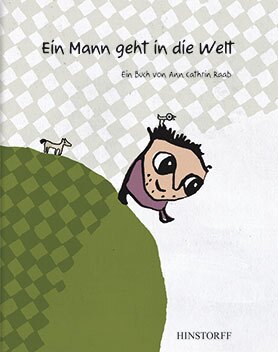Ann Cathrin Raab
Ein Mann geht in die Welt
[A man goes out into the world]
- Hinstorff Verlag
- Rostock 2009
- ISBN 978-3-356-01326-9
- 32 Pages
- 3 Suitable for age 4 and above
- Publisher’s contact details
Ann Cathrin Raab
Ein Mann geht in die Welt
[A man goes out into the world]
This book was showcased during the special focus on Spanish: Argentina (2009 - 2011).
Sample translations
Review
Having won won numerous awards with her first book,Zeckengeflüster (‘Whisperings of ticks’), Ann Cathrin Raab has followed it up with a second children’s book,Ein Mann geht in die Welt (‘A man goes out into the world’), which like its predecessor has been awarded a prize by the Stiftung Buchkunst foundation for its outstanding design. Content and design are once again excellently matched and refreshingly unconventional. This story of a man who sets out to escape the oppressive tedium of life within his four walls will therefore delight not only children but adults too.
And thus the story begins: in a bare room with a single tiny window — not unlike a prison cell — sits a sad-looking man stricken by boredom. Though safe from all the dangers lurking outside, he is also lonely. And so he makes the brave decision to set out and see the world. He peers cautiously around the corner and takes a first step outside. Right by his front door he immediately encounters a little horse-like creature that makes him curious to see more and produces a magical first shadow of a smile on his face. He ventures a bit further — though at first only as far as the garden, where he digs a hole and takes a look at the earth.
But then he becomes bolder still and dares to take a leap into the clouds to gaze down from the airy heights upon all the people down below. And he finds much to discover: in one direction he sees a sandy beach by the sea with frolicking children, in another a large expanse of green grass with people playing football and doing headstands, while over there, right in the middle, he can see his own house. But he doesn’t want to go back there yet, for his adventure has only just begun, and — although he doesn’t realise it — he’s not alone any longer: more and more strange creatures have joined him — a bird with a pink flower, a tiny horse, a sheep — and now accompany him on his voyage across the sea.
Following his journey across the ocean he reaches a far-off land, and there he finds what he has long yearned for: the company of another human being. A beautiful woman stands half-hidden behind a palm tree, and giving her a flower he has brought with him he asks her if she will show him her world. With the flower in her hair she takes him to a cave decorated with drawings, to her clay-coloured village, and to a bubbling spring. In the evening they dance together in the firelight, and the man smiles. Then, when the fire has died down and an .indigo sky speaks of imminent nightfall, they kiss one another goodbye, ever so gently, as a butterfly goes fluttering past.
As twilight descends, the man sets sail for the journey home. But now he needs two boats, for one would not be enough to carry all his new companions: an elephant, a dog, a monkey, a fish, a dragon and the butterfly — to mention but a few.
He arrives back as the moon is rising, and although he is tired, what matters much more is that he is happy. He opens the door to his house, where nothing is quite the same as it used to be. But having seen so much on his travels, the first thing he does is to fall asleep in his armchair. All around him the room glows in the soft light of the stars, the window is bigger, the world beyond is open to our view. Cheerful colours abound, for the companions and memories he has brought back with him are everywhere to be seen. Many are asleep — the elephant atop the door, the dragon at the man’s feet, the fish in the aquarium. Just one of them has remained awake: the woman is standing in the doorway, smiling.
This book appeals not least because it successfully harmonises story-line and design concept. For with each new step that the man takes as he ventures out into the world, the successive pages of the book offer ever more detail. Throughout the book the drawings exhibit exceptionally clean lines, and this lends the characters an almost abstract quality, whilst at the same time cleverly placing their emotions at the heart of the story. This intensity in the illustrations means that great depth of character can be conveyed through just a few strokes of the pen, making the emotional message readily comprehensible to children.
The coloration, too, effectively backs up the narrative in highlighting the developments in the protagonist’s mood: the greys and beiges of the chilly interior spaces towards the beginning stand in contrast to the steadily more colourful discoveries of the man in the wider world as he sails across the deep blue of the sea or discovers his beloved in the warm ochre tints of her far-off land. And whereas the house at the beginning seemed oppressively empty and constricted, all his new companions and their multiple hues are gathered there at the end and make the self-same space look suddenly large and colourful.
This journey into the wide, wide world has not only changed the house, however: it has also changed and enriched the man himself. Everything began when he decided that he wanted to discover things for himself, and by the end of the story his fear of the world has given way to a sense that a journey into the unknown can bring new colour and vigour into one’s life. WithEin Mann geht in die Welt, Ann Cathrin Raab has succeeded in writing a children’s book that encourages its young readers to discover new things about themselves and about other people. For if we approach the world with a large measure of curiosity and attentiveness we can garner friendships and experiences that enable us to see the entire world in a completely different way.

And thus the story begins: in a bare room with a single tiny window — not unlike a prison cell — sits a sad-looking man stricken by boredom. Though safe from all the dangers lurking outside, he is also lonely. And so he makes the brave decision to set out and see the world. He peers cautiously around the corner and takes a first step outside. Right by his front door he immediately encounters a little horse-like creature that makes him curious to see more and produces a magical first shadow of a smile on his face. He ventures a bit further — though at first only as far as the garden, where he digs a hole and takes a look at the earth.
But then he becomes bolder still and dares to take a leap into the clouds to gaze down from the airy heights upon all the people down below. And he finds much to discover: in one direction he sees a sandy beach by the sea with frolicking children, in another a large expanse of green grass with people playing football and doing headstands, while over there, right in the middle, he can see his own house. But he doesn’t want to go back there yet, for his adventure has only just begun, and — although he doesn’t realise it — he’s not alone any longer: more and more strange creatures have joined him — a bird with a pink flower, a tiny horse, a sheep — and now accompany him on his voyage across the sea.
Following his journey across the ocean he reaches a far-off land, and there he finds what he has long yearned for: the company of another human being. A beautiful woman stands half-hidden behind a palm tree, and giving her a flower he has brought with him he asks her if she will show him her world. With the flower in her hair she takes him to a cave decorated with drawings, to her clay-coloured village, and to a bubbling spring. In the evening they dance together in the firelight, and the man smiles. Then, when the fire has died down and an .indigo sky speaks of imminent nightfall, they kiss one another goodbye, ever so gently, as a butterfly goes fluttering past.
As twilight descends, the man sets sail for the journey home. But now he needs two boats, for one would not be enough to carry all his new companions: an elephant, a dog, a monkey, a fish, a dragon and the butterfly — to mention but a few.
He arrives back as the moon is rising, and although he is tired, what matters much more is that he is happy. He opens the door to his house, where nothing is quite the same as it used to be. But having seen so much on his travels, the first thing he does is to fall asleep in his armchair. All around him the room glows in the soft light of the stars, the window is bigger, the world beyond is open to our view. Cheerful colours abound, for the companions and memories he has brought back with him are everywhere to be seen. Many are asleep — the elephant atop the door, the dragon at the man’s feet, the fish in the aquarium. Just one of them has remained awake: the woman is standing in the doorway, smiling.
This book appeals not least because it successfully harmonises story-line and design concept. For with each new step that the man takes as he ventures out into the world, the successive pages of the book offer ever more detail. Throughout the book the drawings exhibit exceptionally clean lines, and this lends the characters an almost abstract quality, whilst at the same time cleverly placing their emotions at the heart of the story. This intensity in the illustrations means that great depth of character can be conveyed through just a few strokes of the pen, making the emotional message readily comprehensible to children.
The coloration, too, effectively backs up the narrative in highlighting the developments in the protagonist’s mood: the greys and beiges of the chilly interior spaces towards the beginning stand in contrast to the steadily more colourful discoveries of the man in the wider world as he sails across the deep blue of the sea or discovers his beloved in the warm ochre tints of her far-off land. And whereas the house at the beginning seemed oppressively empty and constricted, all his new companions and their multiple hues are gathered there at the end and make the self-same space look suddenly large and colourful.
This journey into the wide, wide world has not only changed the house, however: it has also changed and enriched the man himself. Everything began when he decided that he wanted to discover things for himself, and by the end of the story his fear of the world has given way to a sense that a journey into the unknown can bring new colour and vigour into one’s life. WithEin Mann geht in die Welt, Ann Cathrin Raab has succeeded in writing a children’s book that encourages its young readers to discover new things about themselves and about other people. For if we approach the world with a large measure of curiosity and attentiveness we can garner friendships and experiences that enable us to see the entire world in a completely different way.
Translated by Helena Kirkby

By Andrea Müller
